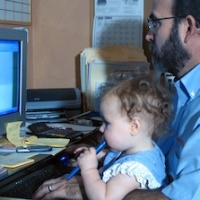How to Manage Work-from-Home Employees

Who wouldn’t want to work from home? For many, it’s the ideal setup, and it’s not surprising that work-from-home arrangements are more common than ever. Then again, when your home becomes uninhabitable, as so many homes did during Hurricane Sandy, some of the potential pitfalls become more visible.
But even during this disaster, imaginative telecommuters sought alternative places to use as temporary offices. All they really needed, after all, was their laptop, a roof, a working light bulb, and an Internet connection. Coffee shops and other wifi-enabled locations quickly became packed.
Making telecommuting work well, though, requires more than the manager saying, “Go for it,” and the employees saying, “Yay!” It’s important that both manager and employees understand the software and tools to be used as well as any associated security risks involved in allowing company data offsite.
More so than with in-office employees, communication is essential—both between manager and employee and between employees. Skype and other telecommunicating software have made it possible for remote employees to be able to attend and participate in meetings. Some managers require that employees have the software on and available during their working hours in case they need to be contacted during the day.
Communication includes investing time in relationships by getting to know the work-from-home employees. Even when face-to-face time will be limited, it’s important to take time to learn about each worker’s strengths, style, development gaps, and aspirations. And just as with on-site employees, the manager should plan on gathering feedback to maintain an ongoing connection with the employees and to recognize and acknowledge their accomplishments.
When managing several work-from-home employees, it’s especially important that the manager provide clearly-stated instructions, guidelines, and expectations regarding how the work will be done and when it’s due. While many work-from-home employees may view it as an opportunity to put the term “flexibility” to the test, managers may want to encourage employees to set consistent schedules. In addition to helping the manager, consistent hours help the employees who need a structured approach to working off-site.
The nor’easter that blew into the Northeast US a week after Hurricane Sandy resulted in 200,000 new outages before the several million outages from Sandy had been repaired. While widespread or long-lasting power outages are rare, it may be important to discuss—before facing the event—what the work-from-home employee can and will do to stay in touch and continue to work during an outage.
Some pundits on the issue of telecommuting recommend installing monitoring software on company computers to ensure that work-from-home employees are staying on task and not using company time for personal business. But I don’t know. Is this going too far?

